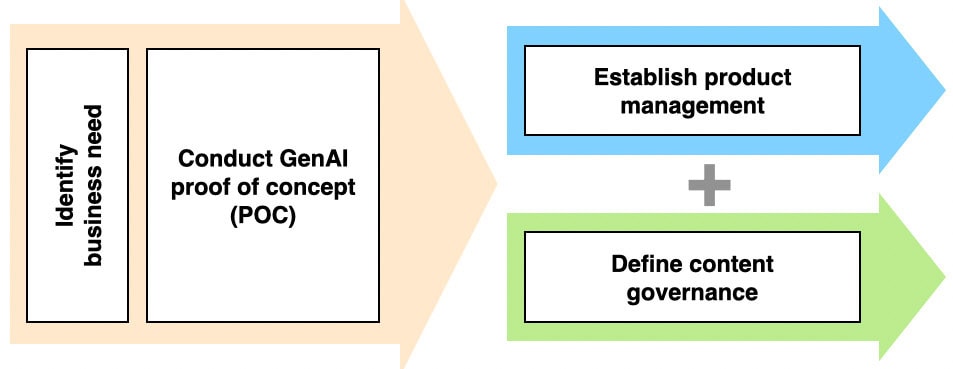
Filed under: AI
It’s been said that “data is the new oil”, and nowhere is this more apparent than in the rise of generative AI (‘GenAI’). While the algorithms they use are important, the ‘knowledge’ of these solutions comes from the enormous amount of data and content the systems have been trained on. By some reports, GenAI has progressed to the point that–in English at least–all the good quality information publicly available in the world has now been utilised. And the emphasis is on quality, because GenAI is only as good as the information it learns from.
In a digital workplace context, relevant answers and information will generally draw on content within the organisation, whether it’s policies, engineering documents or intranet pages. This presents a challenge: the speed of AI projects is incredibly fast right now, with a drive to get solutions live as quickly as possible. The content that underpins the success of these new experiences, however, moves slow and requires long-term management and governance.
Left unchecked, the conflict between fast and slow elements leads inevitably to AI failure. This article outlines a practical approach to make sure the key pieces are in place for sustainable success.
AI, meet content
Many of the key use cases outlined in our AI framework for the digital workplace draw on enterprise content or data. These include:
- querying information collections, which puts a GenAI front-end on to structured repositories of important content
- AI-powered chatbots, which use AI to deliver a chatbot with enough ‘smarts’ to answer many common employee questions
- generating suggestions, where the AI puts forward links to potentially useful content ‘in the flow’ of an employee’s task
- digital workplace information retrieval, perhaps the most challenging AI use as it requires good governance of a very broad spread of information
In each of these cases, the AI draws upon a scoped set of content or data when formulating an answer. This often utilises ‘retrieval-augmented generation’ (RAG), which uses workplace-specific information to supplement the more general information ‘known’ by the generative AI.
The immediate challenge is that if the content is out of date, incorrect or poorly structured, then the answers provided by the AI will be flat-out wrong. (This is a classic example of the age-old ‘garbage in, garbage out’.)
The longer-term challenge is that most AI-based solutions will be delivered as a project, without necessarily having an ongoing business-as-usual component. The content underpinning the AI may have many owners, and almost certainly won’t be owned by the business area that built the AI solution. Without good governance, this content may drift out of date and fail to reflect current policies or processes. Even though the AI itself is still working well, the effectiveness of it steadily degrades over time, as the quality and accuracy of answers drops.
It’s already the case that so much trust has been lost in the information provided by some early-mover AI solutions that employees have abandoned using them.
Deliver success, sustainably
Delivering a successful and sustainable AI solution in the digital workplace need not be complex:
- Identify business need: Even new technologies such as GenAI are just a ‘means towards an end’. Start with an identified business need, opportunity or problem. This is critical in shaping and then assessing the AI solution during the proof of concept.
- Conduct GenAI proof of concept (POC): The AI space is moving so quickly at the moment, that initial experimentation will be required in almost all cases. Conduct a well-structured proof of concept that has clear objectives and defined success measures. This initial work may be done by a IT or digital team, as part of a broader AI push or to ‘test the waters’ of what’s possible.
- Establish product management: If the POC is deemed to be a success, then responsibility should be transitioned to a ‘product owner, who may sit either in IT or in the business (and ideally was involved throughout the POC). Best-practice product management methodology then ensures the solution evolves purposefully over time and it remains aligned with business goals. Ongoing resourcing, including budget and people, must be allocated at this time; otherwise the POC should be ‘paused’ (see below).
- Define content governance: Confirm which content is in scope for the AI solution, and put in place robust governance. This must include clear owners for each piece of content, review and expiry processes, and mechanisms to ensure the content is updated when matching policies or processes change. Where appropriate, existing governance structures can be used, such as those in place for the intranet.
All of these elements are already well understood, it’s a question of bringing them together with the right stakeholders involved from the outset.
Practical tips
- Identify an ongoing product owner before starting the proof of concept, so there is a smooth handover to business as usual (if the POC succeeds of course!).
- Start content governance conversations early, as this is a difficult challenge to address in all organisations.
- Draw in governance expertise from teams that have a strong track record in managing content, such as intranet or knowledge management teams.
- Find a ‘what’s in it for me’ factor for the content owners to keep their content fresh, ideally by ensuring the AI solution benefits them or their business area.
- Be prepared to pause, only deploying the AI solution at scale when product ownership and content governance is in place.
GenAI has the potential to deliver new digital employee experiences that transform business processes and working practices, and organisations should move quickly to reap these rewards. If the practices, processes and appropriate management are put in place from the outset, then projects can move at speed knowing that their efforts will deliver long-term benefits.






